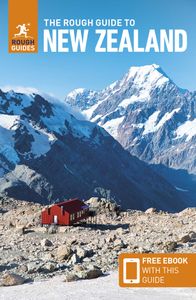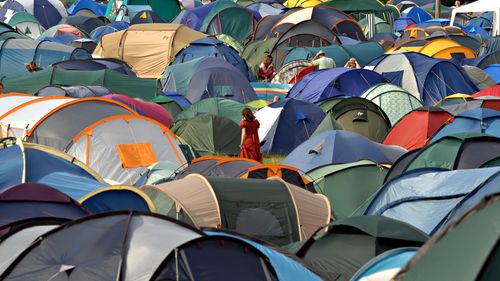The Hutt Valley
At the northern end of the harbour commuter-land spreads along the Hutt Valley, the largest tract of flat land in these parts, accessible along SH2 and by suburban trains and buses. The original founding of Wellington is remembered in Petone’s Settlers Museum, while nearby Lower Hutt has Wellington’s closest campsite, a great art gallery, and is on the way to the rugged Rimutaka Forest Park.
North of Civic Square
As the city progressively reconnects to the harbour, there’s plenty of action around Queens Wharf, home to expensive harbour-view apartments, the Museum of Wellington City and Sea and a variety of bars and restaurants, as well as the Mojo coffee roastery.
The business heart of Wellington beats along Lambton Quay, which runs north to the Parliamentary District, the city’s administrative and ecclesiastical hub. Parliament marks the southern edge of Thorndon, Wellington’s oldest suburb and home of the Katherine Mansfield Birthplace.
The Botanic Gardens
A lookout at the top of the Cable Car provides spectacular views over the city. Here, you’re also at the highest point of Wellington’s Botanic Gardens, a huge swathe of green on peaceful rolling hills with numerous paths that wind down towards the city. Pick up the useful free map from the Cable Car Museum.
Lady Norwood Rose Garden and Begonia House
The star in the Botanic Garden’s firmament is the fragrant Lady Norwood Rose Garden, where a colonnade of climbing roses frames beds of over three hundred varieties set out in a formal wheel shape. The adjacent Begonia House is divided into two areas: the tropical, with an attractive lily pond, and the temperate, which has seasonal displays of begonias and gloxinias in summer, changing to cyclamen, orchids and impatiens in winter.
Carter Observatory
Two minutes’ walk from the upper Cable Car terminus is the fabulous, revamped, 1941 Carter Observatory, which has illuminating displays on the New Zealand angle on the exploration of the southern skies, from Maori and Pacific Island astronomy and astronavigation through to recent planet searches. Of particular note are a telescope from Captains Cook’s era, a piece of moon rock you can touch and the chance to launch a rocket – you man the console, initiate the launch and feel the ground shake as you view the footage of the space bound projectile. Make time to catch one of the jaw-dropping planetarium shows that include live night sky viewings.
Katherine Mansfield
Katherine Mansfield Beauchamp (1888–1923) is New Zealand’s most famous short-story writer. During her brief life, she revolutionized the form, eschewing plot in favour of a poetic expansiveness. Virginia Woolf claimed Mansfield’s work to be “the only writing I have ever been jealous of”.
Mansfield lived on Tinakori Road for five years with her parents, three sisters and beloved grandmother, and the place is described in some of her works, notably “Prelude” and “A Birthday”. The family later moved to a much grander house in what is now the western suburb of Karori until, at 19, Katherine left for Europe, where she lived until dying of tuberculosis in France, aged 34.
Museum of Wellington City and Sea
Near lively Queens Wharf, a Victorian former bond store houses the absorbing Museum of Wellington City and Sea. The city’s social and maritime history unfolds through well-executed displays on early Maori and European settlement and the city’s seafaring heritage. The ground floor offers an easily digestible chronological overview of key events, while the main focus of the first floor is the poignant coverage of the Wahine disaster, remembering the inter-island ferry that sank with the loss of 52 lives on April 10, 1968. The Wahine foundered in one of New Zealand’s most violent storms ever, with 734 people on board. On the top floor, a hologram presentation tells the Maori legends of the creation of Wellington Harbour, while rising up through the centre of the building, a tall screen features a roster of short films. There are also museum tours, including the popular Ship ’n Chip tour which involves a ferry trip to Matiu/Somes Island and fish and chips for lunch.
Parliamentary District
The northern end of Lambton Quay marks the start of the Parliamentary District, dominated by the grandiose Old Government Buildings, which at first glance appear to be constructed from cream stone, but are really wooden. Designed by colonial architect William Clayton (1823–77) to mark the country’s transition from provincial to centralized government, the intention was to use stone but cost-cutting forced a rethink. When completed in 1876, it was the largest building in New Zealand, and except for an ornamental palace in Japan remains the largest timber building in the world. It’s currently occupied by Victoria University’s Law Faculty, but you can usually duck inside, nip up the rimu staircase and see the series of photos of the building as a backdrop to various historical demonstrations and protests.
The Katherine Mansfield Birthplace
A ten-minute walk north from the cathedrals through Thorndon gets you to the Katherine Mansfield Birthplace, a modest wooden house with small garden that was Mansfield’s childhood abode. The house has a cluttered Victorian/Edwardian charm and avant-garde decor for its time, inspired by Japonisme and the Aesthetic Movement. An upstairs room is set aside to recount a history of the author’s life and career, with some black-and-white photos of Wellington and the people that shaped her life – and videos including the excellent A Woman and a Writer.
Riding the Cable Car
Even if you never use the rest of Wellington’s public transport system, don’t miss the short scenic ride up to the leafy suburb of Kelburn and the upper section of the Botanic Gardens on the Cable Car, installed in 1902. Its shiny red railcars depart every ten minutes from the lower terminus on Cable Car Lane, just off Lambton Quay, and climb a steep, one-in-five incline, making three stops along the way and giving great views over the city and harbour. At the upper terminus on Upland Road, the Cable Car Museum contains the historic winding room with the electric drive motor and a cat’s cradle of cables. Two century-old cars are on display along with plenty of background on cable cars around the world. Take time to catch the short movies, particularly the one about the 400-plus mini cable cars people still use to access their properties locally.
South of Civic Square
You’re likely to spend much of your time south of Civic Square visiting Te Papa or eating and drinking around Cuba Street and Courtenay Place, but don’t miss out on Oriental Parade – a lovely stroll with harbour views, a small beach and the chance to hike up to the summit of Mount Victoria.
Courtenay Place and Cuba Street
Wellington’s entertainment heartland is centred on Courtenay Place and adjacent Cuba Street. Named after an emigrant ship (not the island after which the ship was christened, despite the Cuban-themed establishments in this part of town), Cuba Street and its offshoots comprise Wellington’s “alternative” district, with secondhand bookshops, vintage record stores, retro and emerging-designer fashion outlets, quirky cafés, and hip bars and restaurants. Between Dixon and Ghuznee streets, Cuba Street’s colourful and iconic Bucket Fountain was installed in 1969 and still splashes unsuspecting passers-by.
Cuba Street under threat
If not the character then certainly the look of some parts of Wellington is set to change. Many of Wellington’s older, more atmospheric buildings, primarily along Cuba Street and its surrounds, are under threat, having fallen foul of new legislation on building safety, enacted since the Christchurch earthquakes of 2010 and 2011. The cost of bringing these edifices up to standard is, in some cases, prohibitive and may mean their loss to the wrecking ball. As with Christchurch, this is both an opportunity and a bane, since new buildings will almost certainly be high rent, forcing many of the current quirkier occupants to decamp.
Mount Victoria
At 196m, Mount Victoria Lookout is one of the best of Wellington’s viewpoints, offering sweeping views of the city, waterfront, docks and beyond to the Hutt Valley; all particularly dramatic around dusk. If you don’t fancy the steep but rewarding walk, you can also reach the summit by bus (#20; Mon–Fri), the Wellington Rover, or by car following Hawker Street, off Majoribanks Street, then taking Palliser Road, which twists uphill to the lookout.
Oriental Parade
Immediately east of Te Papa, Waitangi Park is named after a long culverted stream that has been restored to its natural course, creating a small urban wetland. At the end of Herd Street, the Chaffers Dock development incorporates cafés as well as the atrium where Wellington’s Sunday-morning farmers’ market sets up. The park marks the start of Oriental Parade, Wellington’s most elegant section of waterfront. Skirting Oriental Bay, this Norfolk-pine-lined road curls past some of the city’s priciest real estate and even flanks a beach installed here in 2003 with sand brought across Cook Strait from near Takaka. Apart from the Freyberg pool and a few restaurants, there are no attractions as such, but you can extend a stroll into a full afternoon by continuing to Charles Plimmer Park and joining the Southern Walkway to the summit of Mount Victoria.
Te Papa
The constantly evolving Museum of New Zealand, Te Papa, rewards repeat visits – you can spend an entire day among the exhibits and still not see them all. A couple of cafés help sustain long visits.
This $350-million celebration of all things New Zealand occupies a striking purpose-built five-storey building on the waterfront and was opened in 1998 after extensive consultation with iwi (tribes). Aimed equally at adults and children (including hands-on kids’ activities in dedicated “discovery” spaces), it combines state-of-the-art technology and dynamic exhibits. Well worth $3 is the Te Papa Explorer guide, outlining routes such as “Te Papa Highlights” or “Kids’ Highlights”. Alternatively, book one of the amazing guided tours.
Level 2
The hub of Te Papa is Level 2, with its interactive section on earthquakes and volcanoes, where you can experience a realistic quake inside a shaking house, see displays on the fault line that runs right through Wellington, watch Mount Ruapehu erupt on screen and hear the Maori explanation of the causes of such activity. There’s also the hi-tech multimedia centre OurSpace, where you can project your own text images onto a giant screen, The Wall, and board two simulator rides ($10 each, or $18 for both): The High Ride, whirling you through the 3D world of The Wall, and the Deep Ride, journeying into a virtual underwater volcano. Level 2 also provides access to the outdoor Bush City, a synthesis of New Zealand environments complete with native plants, a small cave system and swingbridge. From November to March, the hour-long Taste of Treasures tour (11am; tickets must be bought before 10.45am; $24) includes traditional Maori refreshments made from bush plants.
Level 4
The main collection continues on Level 4, home to the excellent main Maori section including a thought-provoking display on the Treaty of Waitangi, dominated by a giant glass image of this significant document. There’s also an active marae with a symbolic modern meeting house quite unlike the classic examples found around the country, protected by a sacred boulder of pounamu (greenstone); check behind the cupboard doors at the back for some imagery that shows both a sense of humour and the incredible significance of the place. Temporary exhibitions include displays by different iwi showcasing that particular iwi’s art and culture.
Adjacent to the marae, look out for displays on New Zealand’s people, land, history, trade and cultures including Michel Tuffery’s bullock made from corned beef cans, and Brian O’Connor’s paua-shell surfboard.
Level 5
Level 5 is the home of New Zealand’s national art collection, displaying a changing roster of works on paper, oils and sculpture representing luminaries of the New Zealand art world past and present; Colin McCahon, Rita Angus, Ralph Hotere, Don Binney, Michael Smither and Shane Cotton are just a few names to watch for.

_listing_1594826609732.jpeg)

















